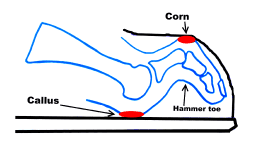Corn
Corns / Calluses


Our bodies have a wonderful ability to protect us from injury. For example, reflexes help us avoid many bumps and bruises. Another protective ability we don’t often think about is the skin’s ability to avoid ulceration. When the foot is getting a large amount of pressure focused in a relatively small area the skin adds layers to protect itself. These extra layers of keratin make the skin less vulnerable to puncture and reduces its ability to break. These added layers are known as callus.
If callus is allowed to collect unchecked it can become very painful, can change how you walk and can lead to open wounds on your feet. This increases your risk of infection.
Callus goes by many names depending upon its location on the foot:
- “Corns” are usually on top of the small joints of the toes.
- “Soft corns” are usually between the toes at pressure points.
- Calluses on the bottom of the feet are usually just called “calluses” but podiatrists typically call them tylomas.
- “seed corns” are painful focused calluses found on pressure spots typically on the bottom of the foot.
Calluses of all types can lead to severe pain and should be addressed with treatment as well as prevention. Typically, trimming the callus will reduce your discomfort but determining why the callus is there will help us prevent its recurrence. Shoes and how we walk in them are often the culprits and modifications of them can lead to the calluses going away due to the reduction in pressure. Shoe adjustments, pads, inserts and orthotics are just a few conservative approaches that can prevent callus formation.
If conservative measures are unsuccessful, surgery might be recommended to help you walk without painful corns and calluses in the future. Contact ETFA and see if he can make each step less painful.
PLEASE NOTE:
The information contained in this article is not intended to provide advice for individual problems, nor to substitute for professional advice or care from a physician. For answers to specific questions concerning your personal circumstances, you should consult your physician directly.
